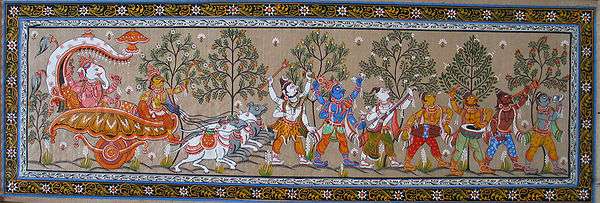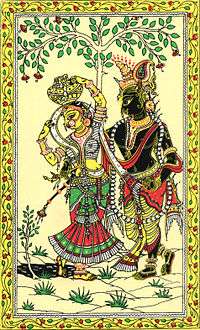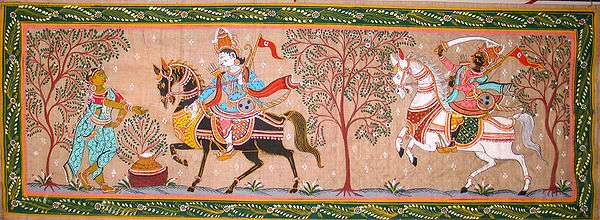Pattachitra
Pattachitra is a general term for traditional, cloth-based scroll painting,[1] based in the eastern Indian state, Odisha.[2] In the Sanskrit language, "Patta" literally means "cloth" and "Chitra" means "picture". Most of these paintings depict stories of Hindu deities.[3]
Odisha Pattachitra
[4] Pattachitra is a traditional painting of Odisha, India.These paintings are based on Hindu mythology and specially inspired by Jagannath and Vaishnava sect.[5] All colours used in the Paintings are natural and paintings are made fully old traditional way by Chitrakaras that is Oriya Painter. Pattachitra style of painting is one of the oldest and most popular art forms of Odisha. The name Pattachitra has evolved from the Sanskrit words patta, meaning canvas, and chitra, meaning picture. Pattachitra is thus a painting done on canvas, and is manifested by rich colourful application, creative motifs and designs, and portrayal of simple themes, mostly mythological in depiction.[6] The traditions of pattachitra paintings are more than thousand years old.[7][8]
Origin and History
The painting the 'pattachitra' resemble the old murals of Odisha especially religious centres of Puri, Konark and Bhubaneshwar region, dating back to the 5th century BC. The best work is found in and around Puri, especially in the village of Raghurajpur.[9]
This old tradition of Oriya painting still survives in the places like Puri, Raghurajpur, Paralakhemundi, Chikiti and Sonepur.In the past professionerise, there was no distinct separation between the master painters and master sculptors; so the possibility of a simultaneous origin of painting and sculptural art in Odisha can not be ruled out. Even today in Odisha, these two crafts are combined inone and these artists and known as Chitrakaras, their title remains mostly Mohapatra or Maharana. Strangely enough, painting appeared in Odisha rather later, several centuries after the construction of the great temples of Bhubaneswar, Puri and Konark.here exists a good number of paintings from 18th century onwards in many temples and Mathas especially in the southern districts of Odisha. Lord Jagannath in the present from is being taken as the origin of the Patta style. The colour schemes of the deities of Puri are quite similar to those of the Patta style. The oldest record of Patta Paintings does not probably go beyond the establishment of the present shrine of Shri Jagannath at Puri. It may be due to the fact that paintings do not survive like sculptures. The paints inside the shrines of Lord Jagannath at Puri make the date probable. The oldest classical marble paintings of Sitabanji at Keonjhar do not conform to the present style of Patta painting wholly. The wooden statues of the three deities are also covered with cloth and then overlaid with glue mixed with chalk, and then given paint only with four limited colours of red, yellow, white and black. The deities who are held in high esteem by the Oriyas and who inspire religion, life and activity of the people also carry with them a tradition of art and painting which is as old as the deities themselves. If the Savara origin of Jagannath is accepted, the date of the Patta paintings can be dated back to an earlier period. These paintings were originally substitutes for worship on days when the temple doors were shut for the 'ritual bath' of the deity.

Theme and Style
The theme of Oriya painting centres round the Jagannath and the Vaishnava sect. Since beginning of Pattachitra culture, Lord Jagannath who was an incarnation of Lord Krishna has been the major source of inspiration. The subject matter of Patta Chitra is mostly mythological, religious stories and folk lore. Themes are chiefly on Lord Jagannath and Radha-Krishna, different "Vesas" of Shri Jagannath, Balabhadra and Subhadra, temple activities, the ten incarnations of Vishnu basing on the 'Gita Govinda' of Jayadev, Kama Kujara Navagunjara, Ramayana, Mahabharata.[10] The individual paintings of gods and goddesses are also being painted. The Pattachitra style are mix of both folk and classical elements but leanings more towards folk forms. The dress style has Mughal influences. All of the poses have been confined to a few well-defined postures. These are not free from monotonous repetitions, though at times this is necessary to accentuate the narrative character of the style. The lines are bold and clean and angular and sharp. Generally there are no landscapes, perspectives and distant views. All the incidents are seen in close juxtaposition. The background on which the figures are represented, is delineated with decorations of flowers and foliages and is mostly painted in red colour. All the paintings are given decorative borders. The whole painting is conceived in the form of a design on a given canvas.
The themes may be classified into following categories[11]
- Jagannath paintings
- Vaishnav Paintings
a)Bhagabat paintings b)Ramayana paintings
- Saiva paintings
- Shakta paintings
- Paintings as legends
- Ragachitras
- Bandhachitra
- Yamapati and yatripatas – (sketches of puri temple) Ganjapa playing card paintings and other socials themes on paintings.
Technique
Traditionally the painters are known as chitrakars. A patta painter's home with all the members of family is his studio. Woman members prepare the glue, the canvas and apply colours what we call the fill-in, and give the final lacquer coating. The master hand, mostly the male member, draws the initial line and gives the final finishing. Patta paintings are done on small strips of cotton cloth. The canvas is prepared by coating the clothe with a mixture of chalk and gum made from tamarind seeds. Then it is rubbed by taking the help of two different stones and then the cloth is dried.The mixture of gum and chalk gives the cloth's surface a leathery finish on which the artists paint with vegetable, earth and stone colours.[12] The painters do not use pencil or charcoal for the preliminary drawings. They are so expert in the line that they simply draw directly with the brush either in light red or yellow. Then the colours are filled in. The final lines are drawn and the patta is given a lacquer coating to protect it from weather, thus making the painting glossy. This process of glazing or varnishing is quite interesting. The painting is held over a fireplace so that the back of the painting is exposed to heat. On the surface of the painting fine lacquer is applied.
Colour
In the 16th century, with the emergence of Bhakti movement the paintings of Radha and Krishna were painted in vibrant shades of orange, red and yellow. There are typical scenes and figures like Krishna, Gopis, elephants, trees and other creatures are seen in these paintings. Krishna is always painted in blue and Gopis in light pink, purple or brown colours.[13]
The painters use vegetable and mineral colours without going for factory made poster colours. They prepare their own colours.[14] White colour is made from the conch-shells by powdering, boiling and filtering in a very hazardous process. It requires a lot of patience. But this process gives brilliance and premanence to the hue. 'Hingula', a mineral colour, is used for red. 'Haritala', king of stone ingredients for yellow, 'Ramaraja' a sort of indigo for blue are being used. Pure lamp-black or black prepared from the burning of coconut shells are used.[15] There was no blue either cobalt or ultramarine in the earlier colour schemes. The colours used in the Patta paintings are primarily bright colours, limited to red, yellow, indigo, black and white. The brushes that are used by these 'Chitrakaras' are also indigenous and are made of hair of domestic animals. A bunch of hair tied to the end of a bamboo stick make the brush.[16] It is really a matter of wonder as to how these painters bring out lines of such precision and finish with the help of these crude brushes.
Palm leaf Pattachitra
Palm leaf pattachitra which is in Oriya language known as Tala Pattachitra drawn on palm leaf. First of all palm leaves are left for becoming hard after being taken from tree.Then these are sewn together to form like a canvas. The images are traced by using black or white ink to fill grooves etched on rows of equal-sized panels of palm leaf that are sewn together. These panels can also be easily folded like a fan and packed in a compact pile for better conservation.Often palm-leaf illustrations are more elaborated, obtaining by superimposing layers that are glued together for most of the surface, but in some areas can open like small windows to reveal a second image under the first layer.[17]
Geographical Indication of Pattachitra
Pattachitra is registered under the identity of Odisha Pattachitra. This ensures the high quality that the artisans of Odisha deliver. The geographical indication ensures that the real artists are not overshadowed by fake claims of pattachitra in the neighbouring regions.[4][18]
Notes
- ↑ SenGupta, pp. 13.
- ↑ "Patta Chitra".
- ↑ SenGupta, pp. 12.
- 1 2 http://odisha.gov.in/e-magazine/Orissareview/2010/November/engpdf/46-48.pdf
- ↑ "Patta Chitra".
- ↑ http://india.gov.in/knowindia/pattachitra.php
- ↑ http://craftorissa.com/b2c/product_info.php?products_id=112
- ↑ "Pattachitra Painting". archive.india.gov.in.
- ↑ http://www.paramparik-karigar.org/bystates/pattachitra.html
- ↑ "Indian Art » Blog Archive » Patta Chitra Paintings". indianart.in.
- ↑ categories of Pattachitra
- ↑ The meticulous process of Pattachitra paintings
- ↑ Radha,Krishna and Gopis in Pattachitra
- ↑ http://www.rabindraart.com/how-to-do-pattachitra.html
- ↑ natural colours used in Pattachitra
- ↑ colour brushes used in Pattachitra
- ↑ http://www.jagannatha.net/painting.html Palm leaf pattachitra
- ↑ "Geographical Indications of India". ipindia.nic.in.
Further reading
- Kossak , Steven (1997). Indian court painting, 16th-19th century. New York: The Metropolitan Museum of Art. ISBN 0-87099-783-1. (see index: p. 148-152)
External links
| Wikimedia Commons has media related to Pattachitra. |
- Patachitra of Medinipur (Midnapore)
- Past of Pattachitra
- Essential Ideas on Pattachita
- Pattachitra Painting
- Pattachitra Photogallery


